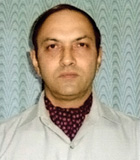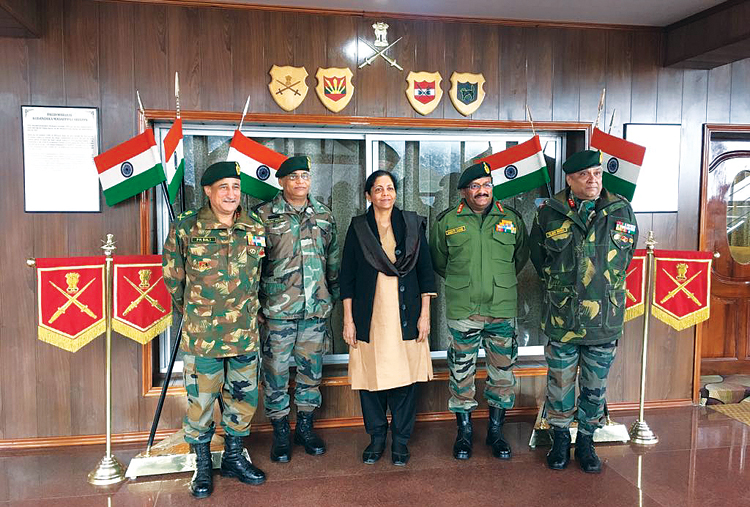INDIAN ARMED FORCES CHIEFS ON
OUR RELENTLESS AND FOCUSED PUBLISHING EFFORTS

SP Guide Publications puts forth a well compiled articulation of issues, pursuits and accomplishments of the Indian Army, over the years

I am confident that SP Guide Publications would continue to inform, inspire and influence.

My compliments to SP Guide Publications for informative and credible reportage on contemporary aerospace issues over the past six decades.
- Prime Minister witnesses 'Bharat Shakti' – a Tri-Services Firing and Manoeuvre Exercise in Pokhran, Rajasthan
- Interim Defence Budget 2024-25 — An Analysis
- Union Defence budget 2024
- Prime Minister Modi Commemorates Indian Navy Day in a Grand Ceremony
- Prime Minister Modi Flies in the LCA Tejas
- New Chapter in India-Italy Defence Ties
- Airpower beyond Boundaries
Nirmala Sitharaman shows the way
The visit of Nirmala Sitharaman to the operational sectors is a very appropriate step for it is not only good for the morale of the soldiery but is an indicative of a dynamic Defence Minister who wants to not only understand the operational dynamics of each theatre of operations but wants to see the actual ground conditions in various sectors of a theatre.
 | By Lt. General V.K. Kapoor (Retd) |

Nirmala Sitharaman, after becoming the new Defence Minister has been very active to say the least. Apart from holding regular meetings with all three Service Chiefs and the defence secretary to ensure quick decision making in her ministry, she has laid special emphasis on the need to step up the pace of military procurement which despite some dynamism shown by the erstwhile Defence Minister, Manohar Parrikar, in the past, the state of equipment procurement and modernisation is entirely unsatisfactory. The Indian Army lacks modern weaponry which includes basic weapons like carbines and assault rifles, artillery howitzers, helicopters, surveillance and communication equipment, air defence and anti-tank missiles, night fighting aids etc all need replacement/procurement. Moreover, till very recently even certain categories of ammunition were in short supply and thus there was no ammunition available even for training. The Minister has also declared that she will also hold meetings of the Defence Acquisition Council once every two weeks. The fact that the Prime Minister of India has entrusted her with this important portfolio also speaks volumes for her administrative talent and past efficiency and she is surely and impressively proceeding ahead.
Visits to Arunachal and Sikkim
Her recent visits to the border areas in Arunachal and Sikkim, aerial survey of Dokalam and Nathu La area, and visits to the Army and Air force stations in the vicinity have evoked very positive responses from the countrymen and the Indian soldiery. These visits are indicative of the great interest she is taking in understanding the operational environment in the Eastern Theatre which we could say has been somewhat neglected by the political leadership in the past. While they are used to sanctioning some projects from time to time the defence ministers in the past seldom went to the forward areas of the line of control (with Pakistan)or the line of actual control (with China) to familiarise themselves with the happenings on the ground and to see for themselves the state of preparedness of the armed forces in the various sectors.
It is generally accepted by all military and strategic analysts that the time has come for the ministry to be manned by a cadre of officers who are skilled in the management of national security issues and in building and establishing military capabilities. A generalist cadre of IAS officers is no longer a viable solution forthe complicated and hybrid nature of wars in the future.
For a long time India has felt the need for an active Defence Minister who was willing to understand issues on the ground and even visit to the high altitude areas to meet the soldiery. George Fernandes, with his large number of visits to the Siachen Glacier, was perhaps the last Defence Minister who was active in this respect. Generally they have satisfied themselves with briefings in the operational rooms/offices but would seldom moved out to the operational sectors. Thus the visit of Nirmala Sitharaman to the operational sectors is a very appropriate step for it is not only good for the morale of the soldiery but is an indicative of a dynamic Defence Minister who wants to not only understand the operational dynamics of each theatre of operations but wants to see the actual ground conditions in various sectors of a theatre. This also has a message for our adversaries that here is a Defence Minister who “means business” and therefore integrity of the border areas will not be compromised.

India welcomes the dynamic and no nonsense approach of the new defence minister, and her noble intentions, however at the strategic level, at which She is required to function, she must get her priorities right. And these include overcoming voids and shortages in equipment and ammunition; modernisation of weapons and equipment; early replacement of obsolescent weapons and equipment; drastic improvement of road infrastructure in the border areas in the east and in the west; integration of the Services with the ministry of defence; operational integration among the three Services through integrated regional commands and last but not the least, acquire the ability to fight on digitised battlefields in the future through net centricity.
Our Recommendations
In the beginning, say for a few weeks, while she familiarises herself with the organisational, functional, and operational details her current activity is not only required but it is absolutely necessary. She should get a first hand feel of the terrain in general and operational conditions existing in various theatres of operations in the nation and thereafter get down to ensuring that the three Services are operationally prepared to face all operational situations that may arise. There is no point in boasting about ability to cater for a two front war if we are operationally not prepared. The best way is to ask the Integrated Defence Staff to hold a National level War Game which she could attend to understand the type of operational scenarios that we may be required to face as a nation and the broad parameters of the grand strategy/national strategy required for handling each scenario. Parts of some discussions could be attended by the Cabinet Committee on Security. This will bring out lessons at national level which could then be implemented with the staff of the Ministry and the three services. We could then say that the defence minister really means business.
Our Ordnance factories are legendary for their lethargic and poor work culture and are responsible for poor state of ammunition reserves in the country.. The Directorate General of Quality Assurance (DGQA) is another organization which is known more for its corrupt practices and inefficiency. Similarly the departments such as the Controllers of Defence Accounts (CDAs) are again establishments which have expanded manifold but have a poor record of competence notwithstanding some islands of efficiency. So perhaps these are areas where the Minister should also pay more attention to because they are ones who are required to provide the logistics (equipment and munitions) and are responsible for the good morale of the soldiery.
It is generally accepted by all military and strategic analysts that the time has come for the ministry to be manned by a cadre of officers who are skilled in the management of national security issues and in building and establishing military capabilities. This cadre can be drawn from the Services as well as the IAS officers who are especially trained in the management of such issues. A generalist cadre of IAS officers is no longer a viable solution forthe complicated and hybrid nature of wars in the future.





